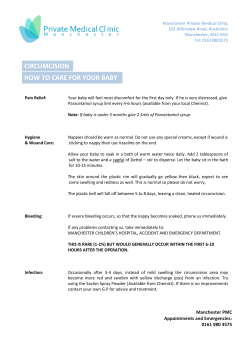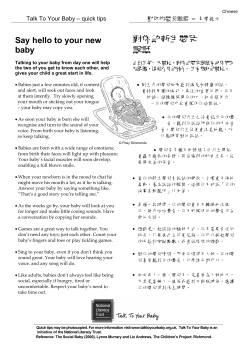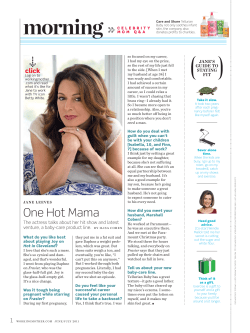
Your Birth Plan - Someday Starts Now
SomedayStartsNow.com Your Birth Plan Someday starts now. #1-465 Your Birth Plan A birth plan can help make sure your preferences are clearly stated. You will have many important decisions to make along the way. Use these pages to write out your plan. Remember, this is only a plan, or a guide. It will help your health care provider understand your wishes. You might want to change the plan when you get closer to your baby’s birth, or you might need to change it if you or your baby has health problems. Show the plan to your partner, health care provider and other people who will be supporting you, and discuss it with them. NAME DUE DATE / / MY DOCTOR OR MIDWIFE name phone number OTHER MEDICAL PROFESSIONALS WHO WILL HELP WITH LABOR (OPTIONAL) List any other medical professionals that you have chosen to help with your pregnancy and delivery. Examples are a lactation consultant or other medical specialist. name title phone number name title phone number DO YOU HAVE A DOULA OR BIRTH COACH — A TRAINED PROFESSIONAL WHO PROVIDES PHYSICAL, EMOTIONAL AND INFORMATIONAL SUPPORT BEFORE, DURING AND AFTER LABOR? name phone number WHERE DO YOU PLAN TO HAVE YOUR BABY? hospital, birthing center or home city WHO IS THE MAIN PERSON WHO WILL BE WITH YOU DURING THE BIRTH? This person is sometimes called your primary support person and might be your partner, a family member or a friend. name Make sure you tell your health care providers and the people supporting you what choices are most important to you. Ask them to help you have the kind of birth that you want to whatever extent that is possible. phone number relationship WHAT ARE THE THREE MOST IMPORTANT THINGS THAT YOU WANT YOUR BIRTH TEAM TO KNOW ABOUT THE KIND OF LABOR AND DELIVERY EXPERIENCE THAT YOU WOULD LIKE TO HAVE? SomedayStartsNow.com 1 Before Labor Starts The following birth plan is intended for use by women experiencing an uncomplicated pregnancy and may need to be modified in consultation with your clinician in high-risk pregnancies. This document should not be considered a form of medical advice and should not replace a doctor’s direction. In a healthy pregnancy, most medical professionals recommend that you let labor start naturally. This usually happens between 39 and 42 weeks. However, some moms need an induction. Induction is when the doctor does something to help the labor start, like giving you a drug or breaking your water. If my baby is late, please counsel me on how long is safe to wait for labor to begin on its own so I can make an informed decision about inducing delivery. I do not want my water broken unless it’s medically necessary. Labor Ask your health care provider to help with the medical parts of your plan. To help me during labor, I would like to try: (Check any that apply.) Breathing support Birthing stool Massage Squatting bar Moving around Laboring in the shower, bathtub or pool Birthing ball If you labor in a hospital, the medical staff will monitor you and your baby’s heart rate. This helps them know if you are or your baby is in danger. Monitoring may be continuous or intermittent. Continuous monitoring usually means you need to stay close to the birthing bed because of the wires. Intermittent monitoring will be done by checking the heart rate at regular intervals. I prefer the baby to be monitored: Continuously. I understand this means my movement may be limited during labor and that I will have an increased risk of cesarean birth or of delivery using instruments such as forceps or a vacuum. You will need your support person and medical providers to help with the labor techniques you have chosen. Make sure they see your birth plan and that they understand your goals for labor and delivery. What drugs, if any, do you want to help with labor pain? Intermittently, to allow for as much mobility as possible. I understand this means we may not constantly know the baby’s heart rate. Other Considerations After researching labor, you might have some other requests. Here are some common ones, or fill in your own. There are many ways to labor. Discuss your options with your doctor and talk to friends and family about their experiences. You can also read about labor in pregnancy books and online. (Check all that apply.) None An epidural or spinal analgesic Always keep my door closed while I am in labor. I would like to labor at home as long as possible. Other Use a local anesthetic for repairs if I tear during delivery. IV drugs for pain No stirrups, unless I’m having a medical emergency. I plan to go to the hospital as soon as my doctor recommends it. If induction becomes medically necessary, I want the r and deliverdoctor at home. to use the following. (Ask your health care provider to explain all of these procedures before you decide.) (Check all that apply.) Stripping membranes Other special requests Movements and Positions Moving and positioning yourself when you have contractions can decrease pain and help the baby move through the pelvis. Take some time to learn these positions and check the ones you like the best. Standing supported squat Squatting Leaning or kneeling forward with support Sitting on a toilet Side-lying Semi-sitting on back with legs raised Pitocin (hormone delivered via IV to stimulate dilation) Sitting Standing Rupturing membranes (breaking the bag of waters) Walking Knees to chest Prostaglandin gels (hormone gel applied to the cervix to stimulate dilation) SomedayStartsNow.com 2 C-section If you require a C-section, you have some choices to make. (Check all that apply.) I want my primary support person with me at all times during the C-section. I would like to remain conscious during the C-section if it is medically appropriate. I want to hold my baby as soon as possible in the delivery room. If my baby is healthy, I would like to breastfeed as soon as possible. If I am unable to hold my baby, I would like my support person to be with the baby and hold him or her as much as possible until I am able to hold the baby. Please do not remove my baby from skin-to-skin for at least an hour or until my baby has breastfed, whichever is longer. Please delay vitamin K, ointment in the eyes and bathing until after the first hour AND until my baby has had the first breastfeeding. After this, please perform procedures with my baby skin-to-skin when possible. I would like to observe all newborn routine procedures. Some families choose to save or donate the blood from the baby’s umbilical cord. The cells in this blood can be used to treat certain serious illnesses and conditions later in your baby’s life. If you choose to save your baby’s cord blood, you will need to set this up before the birth. See your doctor to learn more about your options. I would like to save my baby’s cord blood. I would like to donate my baby’s cord blood. Things to Remember: Pack your hospital bag ahead of time. Install your car seat ahead of time. If my baby is sick and/or needs medical attention, I would like the medical team to follow up with me as soon as possible after my baby’s health is stabilized to discuss breastfeeding and other elements of bonding that might need to be delayed for my baby’s welfare. Go to all your prenatal care check-ups. I still want to breastfeed if at all possible. Bring a list of your medications and emergency contacts with you. Please let my partner and me touch and hold the baby as much as possible. We want to bond with the baby and monitor his or her medical treatment. Birth and Postpartum Recovery I understand that my choices below may need to change depending on my baby’s medical condition. If my baby is healthy and medically stable: As long as my baby is healthy, I would like my baby placed immediately skin-to-skin on me. Please delay any new baby procedures, like bathing and diapering. If my baby is a boy: I want him to be circumcised. I do NOT want him to be circumcised. Do NOT give my baby any of following without discussion with me first: (Check all that apply.) Feeding My Baby Please show me how to feed my baby by showing me and explaining: (Check all that apply.) The risks and benefits of different feeding types. How to know when my baby is hungry. How to know when my baby has had enough to eat. How to position my baby for feeding. What a good latch looks and feels like. The normal amount a baby needs to eat in a day. How to know if feeding is going well. Who I can call if I need help with feeding while I am in the hospital and after I go home. Ways, other than feeding, to comfort a fussy baby who is not showing hunger cues. I would like the following special traditions or requests carried out as part of my child’s birth: Be sure to share your birth plan with your health care providers and everyone who will be supporting you through your pregnancy and delivery. At a prenatal visit, ask about having a copy placed in your medical chart. And remember to bring it to the delivery too. Formula Pacifiers Any artificial nipples Sugar water SomedayStartsNow.com 3
© Copyright 2025









